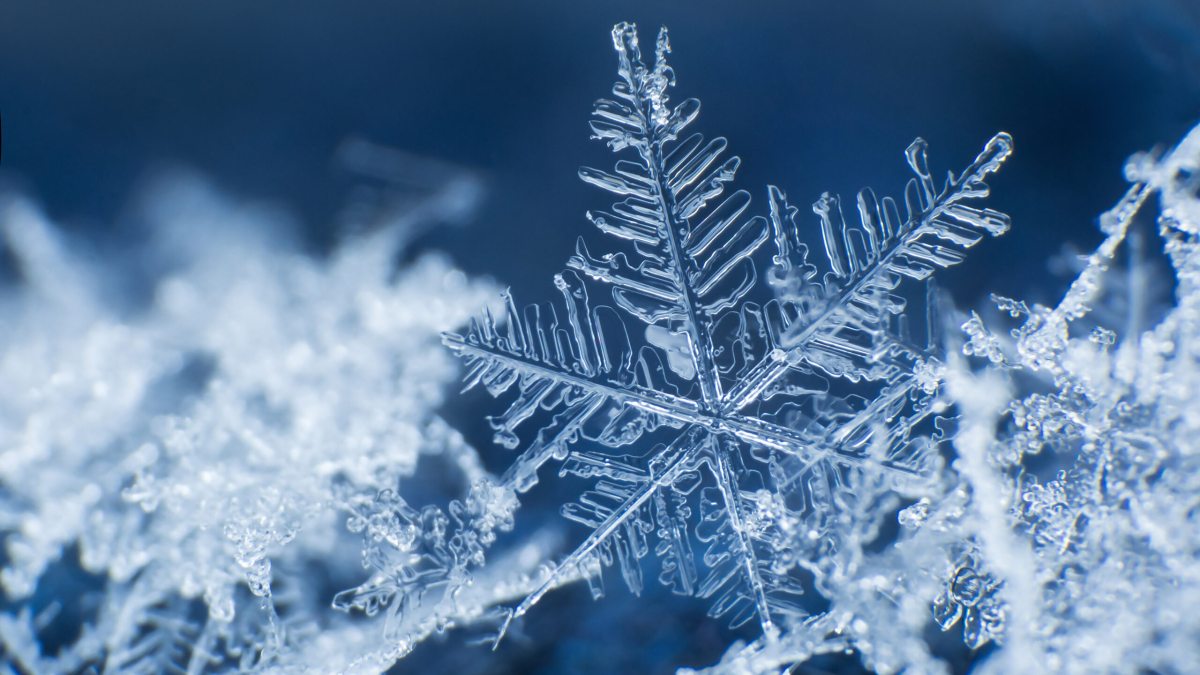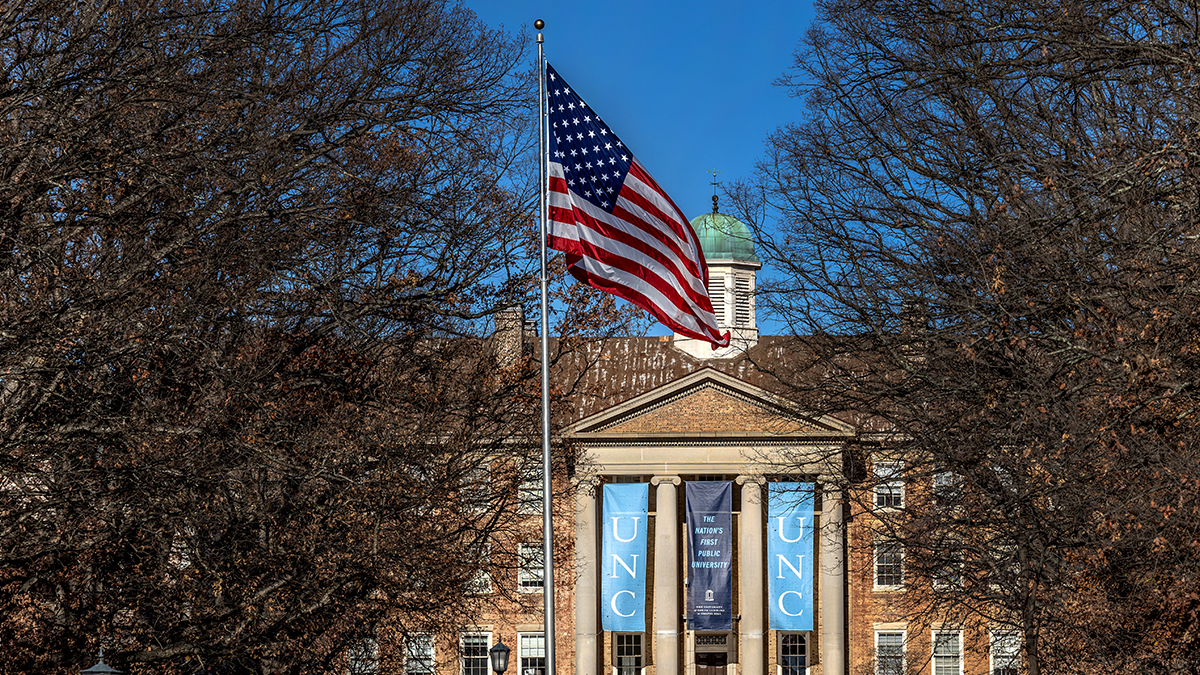The science and poetry of snowflakes
Whether you see them as “water with wings” or “hexagonal dendrites of ice,” snowflakes bring magic and wonder. Some even come from the Bahamas.

Editor’s note: This story was originally published in January 2021.
Think of snowflakes, and what immediately comes to mind?
Floating, feathery crystals that make you feel like you’re in a snow globe?
Or, do you think of tiny hexagonal dendrites of ice formed through the Bergeron Process?
Whatever your thoughts, Carolina has the right folks to delight and inform us on either view and much, much more about snowflakes.
Let’s start by having climatologist Charles “Chip” Konrad unpack the facts about how snowflakes form. Then Michael Chitwood, Carolina professor and poet, will explore the lyrical wonder of snowflakes.
Konrad is director of the University’s Southeast Regional Climate Center and is also a professor in the geography department in the College of Arts & Sciences. He teaches classes such as Introduction to Weather Climate, in which he says students often express fascination with snowflakes.

Charles “Chip” Konrad
Snowflakes are formed by what meteorologists call the Bergeron Process, named for Swiss meteorologist Tor Bergeron, who studied clouds and precipitation. It begins in the coldest part of a cloud, where temperatures range from minus 12 degrees to minus 2 degrees Fahrenheit.
“We know in the atmosphere that the temperature drops rapidly with increasing height,” Konrad said.
The unique environment of clouds contains super-cooled water, ice crystals and water in a gas state or vapor. Snowflakes begin when the super-cooled water makes contact with a microscopic ice crystal. At that point, water vapor near the ice crystal gets deposited onto the crystal, going directly from a gas to a solid, a process called deposition.
A snowflake is born.
“They start off as microscopic ice crystals that are hexagonal with these six faces on them,” Konrad said. “There’s some preferential deposition on the corners of the hexagon and over time that’s where the crystal grows.”
The growth forms branches to become a dendrite, a fancy term for a tree shape with a main trunk and big branches sprouting out to smaller branches. “The tree builds out on a microscale as the snowflake gets bigger and bigger until gravity takes over and it falls,” Konrad said.
A microscopic tree! Hold that thought as we look at the poetic properties of snow.
“Water with wings”
Chitwood, a teaching assistant professor of English and comparative literature, has published nine books of poetry. He knows a thing or two about aesthetics. So, why do snowflakes fascinate us?

Michael Chitwood
“It’s the movement,” Chitwood said. “They don’t go down like rain. Sometimes they actually go back up, which makes me think of them as water with wings.
“Even people who live in places where it snows a lot think they’re a beautiful, graceful thing to watch. Whereas rain is kind of a pedestrian everyday occurrence, well, snowflakes, like the song says, create a winter wonderland.”
To illustrate one beautiful property of snowflakes, Chitwood points to what is arguably the most famous snowfall in American literature. It’s the sound of snowflakes on the wind, described in the third stanza of Robert Frost’s “Stopping by Woods on a Snowy Evening.”
Whose woods these are I think I know.
His house is in the village though;
He will not see me stopping here
To watch his woods fill up with snow.My little horse must think it queer
To stop without a farmhouse near
Between the woods and frozen lake
The darkest evening of the year.He gives his harness bells a shake
To ask if there is some mistake.
The only other sound’s the sweep
Of easy wind and downy flake.The woods are lovely, dark and deep.
But I have promises to keep,
And miles to go before I sleep,
And miles to go before I sleep
Yes, we’ve heard that sweeping sound and others, too. “There’s also a kind of ticking sound that snowflakes make when they hit the ground,” Chitwood said.
Sound makes Konrad, the scientist, think of one of the more interesting properties of snowflakes — their effectiveness at absorbing sound. “It’s so quiet oftentimes, particularly if it’s snowing so heavily that sounds get extremely muted. I think that speaks to the aesthetic, the sound of the quietness as they fall,” Konrad said.
A poetic Bergeron Process
Chitwood also presents a poetic Bergeron Process in “Because You Asked about the Line between Prose and Poetry” by Howard Nemerov.
Sparrows were feeding in a freezing drizzle
That while you watched turned into pieces of snow
Riding a gradient invisible
From silver aslant to random, white, and slow.There came a moment that you couldn’t tell.
And then they clearly flew instead of fell.
Chitwood’s analysis: “He’s saying, OK, this is the rain (prose). And then, when it becomes snow and clearly flies far away, it becomes poetry.”
Another property illustrates beautiful science — reflection. Konrad calls a snowflake’s ability to reflect an important scientific property. “When snowflakes fall out of the clouds, you can see the cloud looks really fibrous in an attractive way. That’s because the snowflakes are reflecting the sunlight, as they are sublimating away from their crystalline form to an invisible gas.”
Memories
Snowflakes often evoke memories.
Here’s one. Chitwood grew up in Franklin County, Virginia, and remembers how a snow forecast put school children on high alert for a day of sledding instead of class. He would find a switch in the living room and turn on the outside floodlight “eight or ten times” before going to bed, hoping to see some snowflakes in the air. “It was the anticipation,” he said.
Konrad also remembers. He and his wife were driving up Colorado’s Mount Evans on the highest paved road in the country. It was an early June day and at about 11,000 feet the view opened up to reveal the bottoms of thundershowers well below them. “My wife and I got up so high we could see the snow coming out of these clouds as we took in some really spectacular views,” he said.
Facts to amaze your family and friends
- Drop this one during the next snowfall: Some snowflakes come from the Bahamas!
Lots of people know that the majority of water vapor in clouds comes from evaporated moisture from oceans, seas, lakes and rivers, but can we tell with high certainty where that water originated? The answer is yes, and Konrad points to examples.
A former Carolina geography doctoral student, Chris Fuhrmann (now a professor at Mississippi State), used what meteorologists call a “back trajectory” to study the record snowfall that dumped 20.3 inches on Chapel Hill in January 2000. “He used a sophisticated tool to determine the origin of the air in which the snow formed, that sweet spot of minus 12 to minus 2 degrees. Believe it or not, that air was in the Bahamas one day prior,” Konrad said. When that warm air laden with Bahamian water was pulled northward and lifted, it expanded and cooled dramatically from the upper 60s to the single digits.
Twenty inches of snow fell overnight, including 5 inches in one hour, all a beautiful crystalline gift from the Bahamas.
Konrad said that trajectory analysis strongly suggests that some snowflakes may begin as tiny crystals in a cloud over the subtropical Pacific Ocean, then grow through the deposition of water vapor originating from the Gulf of Mexico before falling downward and picking up even more water vapor in an air pocket imported from the Atlantic Ocean. “That puts the finishing touches on the dendrite’s outer edges,” Konrad said.
Think of the possibilities. Our snowflakes could be made of water from around the world.
- Did you know that snowflakes often form on hot, humid days.
Summer thunderstorms about 18,000 feet up and higher in the atmosphere create ice crystals as the temperature is less than 12 degrees Fahrenheit. “They’re in clouds, even in the summertime,” Konrad said. “The highest clouds, the cirrus and cirrostratus, oftentimes are producing snowflakes, and during the Bergeron Process, they fall out of the clouds and sublimate away, going directly from ice back into a vapor state.”
- Here’s something to look for while out for a spring walk.
Konrad mentions March as a time of occasional snow-related beauty. That’s when cumulus clouds, “the cotton balls,” can, in an exceptionally cold atmosphere, produce snow that gives the clouds a fibrous and streaked appearance against a blue sky. “The beauty of the sun setting as those snowflakes fall and evaporate in the air; that’s not uncommon to see in the late winter and in the early spring.”
- Then, there’s this thing called rime. What is rime and where does it come from?
Konrad said that riming occurs when super-cooled water freezes in the gaps on the dendrite before reaching the ground. The flake gets fatter and heavier, then falls with others to resemble crunchy, heaped-up sugar on the ground.
“It’s analogous to a tree in an ice storm, where the interstices or the open spaces between the branches and twigs get filled in by the freezing process.”
Whatever the form — floating or free-falling — snowflakes are one of nature’s wonders.
“Even when they’re melting and denser, when their terminal velocity increases, that instills the same excitement and wonder for any school child looking out a window or at age 92,” Konrad said.




